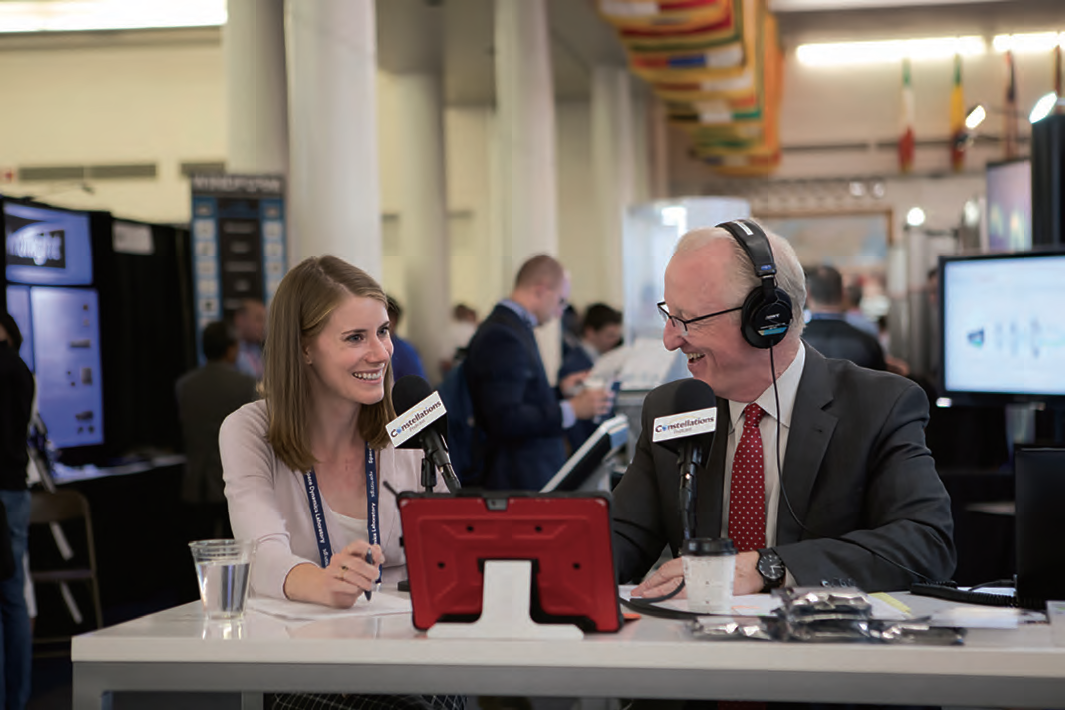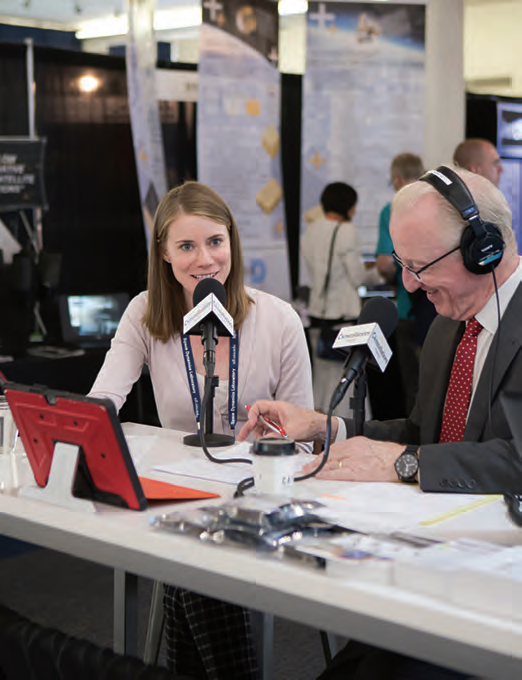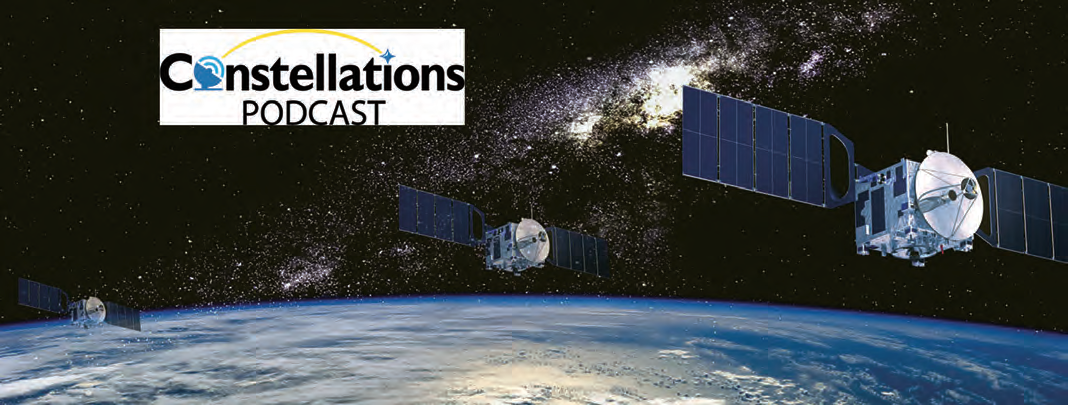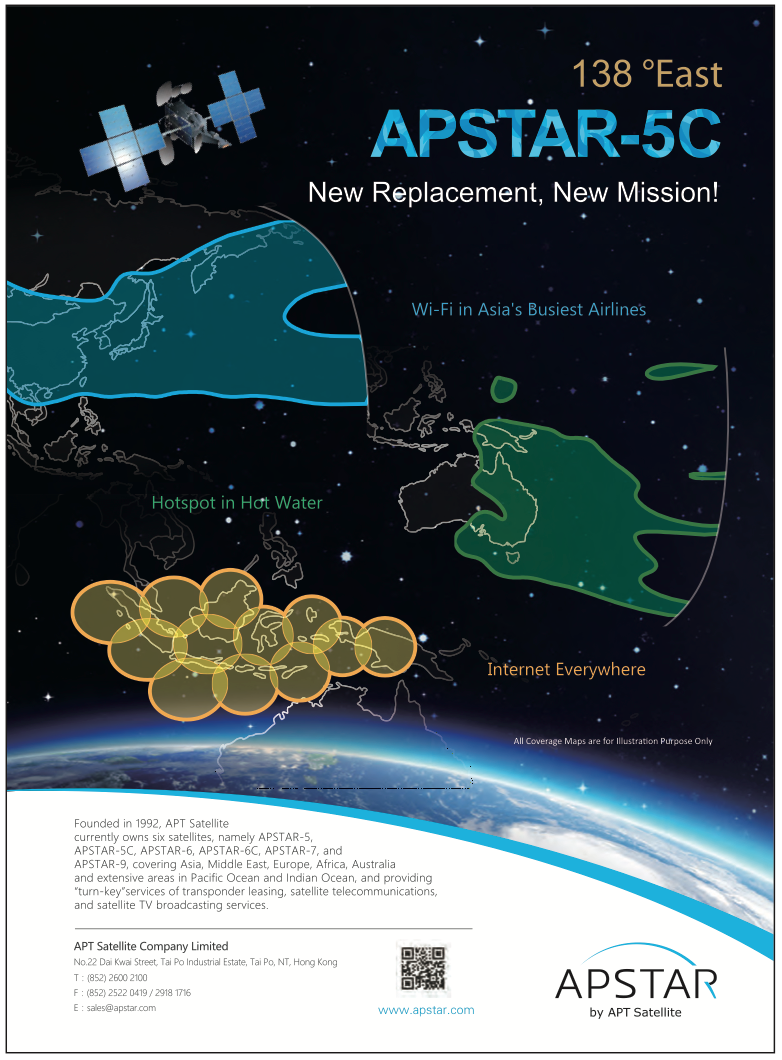The Kratos Constellations podcast connects listeners to the innovators, entrepreneurs, policy makers and disruptors who are making and remaking today’s satellite and space industries.

Carolyn Belle, former senior analyst at NSR and currently the Director, Business Development for KSAT Lite USA, provides insights on emerging new applications and how the smallsat industry is impacting the market. Carolyn built NSR’s practice in smallsats. The original interview is edited for brevity and format.
— Listen to this and 40 other podcast interviews on Constellations —
www.kratoscomms.com/constellations-podcast-sm
John Gilroy for Constellations
Five Thousand. That’s the magic number of smallsats reported as launching within the next decade. Is that correct?
Carolyn Belle (CB)
Actually, we now anticipate about 6,000 satellites launching toward 2027, which is expected to generate more than $25 billion of revenue for manufacturing and launch providers. With more smallsat capabilities and developments in the market, it’s not a surprise that we’re seeing this growth.
Constellations
What’s the breakdown between government and commercial?
CB
It’s very much a commercial market — about 70 percent from commercial providers. About 20 percent are from government or military entities around the world. Many government players are interested, and we’ve seen lots of military adoption as of late. We’re seeing the opportunities smallsats can provide, the way they can work in tandem with larger more capable satellites. By including smallsats in the architecture, you get additional capabilities, a more robust set of assets in orbit.
Constellations
Government has traditionally driven space investment. How much is coming from Silicon Valley and will it continue?
CB
We see ongoing interest from Silicon Valley. It’s still focused there, but we see a broader set of investors around the world. There’s been rampant growth and investment the last few years, but we may be approaching a bit of a slowdown. As investors look at the early funded companies — the Planets, the Spires that were successful coming out — there’s a bit of a wait to see how those perform, how much revenue they get back, and what the exit looks like before a fresh range of investment.
Constellations
How does the timeline for this industry impact the appetite for return?
CB
The space industry has traditionally been a very long timeline business, but with smallsats, the scale at which you can take something from design to testing to implementation is a much shorter period. That reduces the time for investor return.
Constellations
Many are optimistic about the planned constellations. Assuming one is successful, how will that affect the large satellite operators?
CB
That depends on the application. If its smallsats for earth observation, that’s a different potential impact than for communications, which is getting a lot of interest given it’s the largest commercial segment. That is where the GEO operators are nervous. With the mega constellations in development – OneWeb, SpaceX, LeoSat, Telesat – they’re nervous should one of those be successful.
Even though none are deployed yet, we’ve seen an impact where the GEO players are holding off on ordering replacement satellites. They’re not sure how much of their market is going to be taken by one of these LEO players. But they’re also getting more creative, taking a few more risks in orbit to provide a more robust set of capabilities that may be better able to compete with the smallsat players. So we’re seeing hesitancy, but then creative ways to move ahead and still do well.
Constellations
Even with optimism, there will be winners and losers. Will Silicon Valley make the right bets? Is this a horse race that no one knows who to bet on?
CB
Absolutely. Some make more sense than others. We see investors making plays for a wide variety of applications. Some investing in hardware, some on the operators who want to put up a constellation. Not all will be successful. We’ll see some failures. We already see some saturation where there are too many players going after the same thing. And, it’s not just what market you go after. It’s how you design your system, how much financing you have, how much R&D is needed, and regulatory factors. There are many challenges.
Constellations
What’s the environmental impact of having 5-6,000 new satellites in space?
 John Gilroy, the host of Kratos Constellations podcasts, interviewing Carolyn Belle, former senior analyst at NSR and currently the Director, Business Development for KSAT Lite USA. Photo is courtesy of Kratos.
John Gilroy, the host of Kratos Constellations podcasts, interviewing Carolyn Belle, former senior analyst at NSR and currently the Director, Business Development for KSAT Lite USA. Photo is courtesy of Kratos.
CB
People are certainly nervous. Responsibility will be on satellite operators to treat the spectrum environment carefully. Spectrum is a limited resource, so we have to think about interference from all these satellites. You also have to look at avoiding potential collisions in orbit. Space traffic management is really an issue.
Constellations
The cynic says ‘there’s going to be collisions, people are going to make mistakes.’
CB
Hopefully not. Operators are aware of that risk, and they’re working to mitigate it as much as possible. One solution is propulsion. Not all smallsats right now are outfitted with propulsion, which limits their ability to respond in orbit to a potential collision with another satellite or with a piece of debris. That capability will help them to respond more quickly, potentially enabling both parties to respond rather than if there’s only one with propulsion.
You also have growth in de-orbiting devices, so that as soon as the satellite is no longer operational, it can more quickly exit space rather than waiting for this 25-year rule of slow de-orbiting.
Constellations
What about some of the other smallsat markets, like satellite refueling, life extension, and salvage?
CB
Yes. We see a lot more diversity coming from smallsats than we had with large satellites to begin with. With smallsats, there’s a huge variety of applications, services, and sets of data that players are looking to provide. Also this potential for smallsats to play a part in satellite servicing and robotic work in space.
Right now, the plans are for larger satellites to manipulate large GEO satellites in orbit. But we see some smallsat activity. Some university projects are looking to develop robotics from a small profile satellite to interact with others in orbit.
Constellations
It seems robotics in space would bring lots of different skill sets and people, from mechanical engineers and computer scientists to students?
CB
There’s lots of interest from the student community. With smallsats, you can get hands-on experience while in university or even high school. Previously space was something that you didn’t really touch until your first post-grad job. Now you can hold it, build it, and put something in space.

Constellations
In software, there’s ‘killer apps.’ Anything on the horizon for smallsats?
CB
There are players looking to find that killer app and some who think they have. I’m of the opinion that there’s no single killer app for smallsats. There’s lots of different value that can be provided with today’s capabilities and those in development.
Constellations
For example?
CB
Situational awareness, whether on the military side or civilian. Also IoT, tracking everything that’s happening on earth. Imagery has been a leading application of the smallsats deployed, but we’re seeing other types of earth observation being pursued too. Synthetic Aperture Radar is something that smallsats are looking to do, which has been a technical challenge.
People are looking to do many things with space. Collecting other types of atmospheric data, financial applications of using smallsats, leveraging the security of space, entertainment, and marketing. It’s a question of how rapidly they can develop those markets, whether there’s enough downstream potential, and building out the distribution network to tap into and convince those customers to use the service.
Constellations
You wrote that smallsats are simply another piece to the value creation puzzle.
CB
Yes, it’s important to remember that the space industry is much broader than just the smallsat industry. We still have very viable capabilities provided by large satellites in GEO and LEO, and using those assets together can potentially provide more value than in isolation. Smallsats aren’t the entire picture. You can potentially get a lot more value if you take a more cohesive approach.
Constellations
What are the options for getting smallsats in space besides the traditional hitchhike or ride share?
CB
Ride share is still the dominant way to get into orbit. You have some dedicated launch but it is limited due to cost as well as the availability of right size vehicles to do that. We’ve also seen deployments from the International Space Station. Satellites are going up on a cargo vehicle to the ISS and then deployed out of the airlock. That’s been a great way to get into orbit, especially for university projects that are funded by NASA or other international space agencies.
However, launch has been a bottleneck. It’s challenging to get a launch or the right launch. Are you launching when you want, is there a delay, and are you launching where you want to? Often with ride shares, you can’t go to your exact orbit, so it’s more liking getting on a bus, getting dropped off and then figuring out how to get to where you want to operate. That ties back to the importance of propulsion, because those capabilities help you maneuver that gap.
We have a huge array of startups looking to address that issue, to provide dedicated smallsat launches at a more reasonable price and higher level of availability. So, operators who want more control and flexibility over their launch may feel it’s worth it to pay more to launch on schedule and get to their orbit.
Constellations
NASA is coming up with its venture class launch services (VCLS) that could help answer the question about launch capabilities for smallsats. Will that change the situation?
CB
It could. NASA has awarded three VCLS contracts to date, and these players are trying to provide those dedicated smallsat launches. It certainly helps when you have government investment. We saw that on the larger launch side with NASA funding the SpaceX development of the Falcon 9 for cargo deliveries. That can have an impact but we need more private investment. There’s also a technical challenge. NASA’s work on VCLS helps but we need to see much more advancement.
Constellations
Smallsats like the u-class size CubeSats do not have internal propulsion. There’s talk of electric propulsion. Your take on this concept?

CB
We need to see more propulsion capability for smallsats and many are working on it. It’s important for collision avoidance and for optimizing the launch. There’s an array of electrical and chemical solutions, and I wouldn’t pick a winner in that race because the propulsion type is unique to the mission requirement. What sort of mass are you moving, to where, and how quickly do you want to get there? There are trade-offs along the way.
Constellations
Do you think smallsats will ever live up to the hype?
CB
There’s been lots of hype around this market, both within the space industry and more broadly in the mainstream media. There were promises from smallsat players about the value that could be created, and we’re still waiting.
We’ve seen consistent delays in deployment. We only have one operational constellation and it’s still building out the business. And smallsat operators are adjusting their business plans in response to a constantly changing market. People are working on many different elements to bring that hype to fruition but we’ve only begun to scratch the surface.
Constellations
Thank you, Carolyn Belle.
Want to hear from more movers and shakers? Listen to the Constellations podcast. Subscribe at:
www.kratoscomms.com/constellations-podcast-sm
Have a topic you’d like us to discuss? Email us at:
Podcast@KratosComms.com


